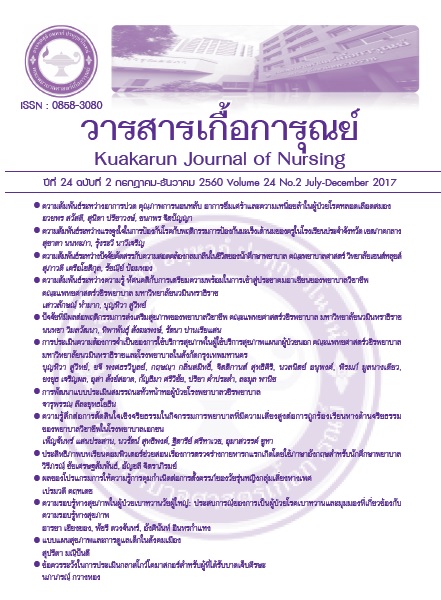ข้อควรระวังในการประเมินกลาสโกว์โคมาสกอร์ สำหรับผู้ที่ได้รับบาดเจ็บศีรษะ
คำสำคัญ:
กลาสโกว์โคมาสกอร์, บาดเจ็บศีรษะบทคัดย่อ
บทคัดย่อ
การประเมินผปู้ ่วยได้รับบาดเจ็บศีรษะมีความสำคัญมากและต้องได้รับการช่วยเหลืออย่างเร่งด่วนและต่อเนื่องเนื่องจากเป็นภาวะคุกคามต่อชีวิต มิฉะนั้นผู้ป่วยอาจเสียชีวิตหรือพิการอย่างถาวร
ปัจจุบัน การใช้แบบประเมินกลาสโกว์โคมาสกอร์ประเมินความรู้สึกตัวซึ่งเป็นที่ยอมรับว่าเป็นเครื่องมือมาตรฐานระดับสากล และใช้กันอย่างแพร่หลาย พยาบาลเป็นบุคคลสำคัญที่สุดในการ
ประเมินความรู้สึกตัวของผู้ป่วยอย่างต่อเนื่อง ต้องมีความรู้ความเชี่ยวชาญในการประเมิน และสามารถแก้ไขปัญหาในการประเมิน จากประสบการณ์ของผู้เขียน พบว่ามีปัจจัยหลายอย่างที่ทำให้
ผลการประเมินกำกวม และไม่สามารถบอกคำนิยามของการลืมตา การสื่อภาษาและการเคลื่อนไหวในแต่ละระดับได้อย่างชัดเจน ผลการประเมินจึงต่างกัน โดยเฉพาะอย่างยิ่งการประเมินผู้ป่วย
ผู้สูงอายุที่บาดเจ็บศีรษะ ความดันโลหิตต่ำ พร่องออกซิเจน อุณหภูมิร่างกายต่ำกว่าปกติ ระดับน้ำตาลในเลือดต่ำ ได้รับยากล่อมประสาท หรือมีระดับแอลกอฮอล์ในเลือดสูง ซึ่งในภาวะดังกล่าวมีผลต่อการทำงานของระบบประสาท อันอาจทำให้ผลการประเมินกำกวม หากทราบข้อควรระวังในการประเมินกลาสโกว์โคมาสกอร์จะช่วยให้แปลความหมายของคะแนนได้เที่ยงตรง และมีความมั่นใจในการประเมินมากขึ้น
เอกสารอ้างอิง
files.wordpress.com/.../e0b8aae0b8a3e0b8b8e.
นลินี พสุคันธภัค, สายสมร บริสุทธิ์ และวันเพ็ญ ภิญโญภาสกุล. (2559). แนวทางการพยาบาล ผู้ป่วยโรคหลอดเลือดสมอง สำหรับพยาบาลทั่วไป. กรุงเทพฯ: ธนาเพรส.
บุญเลิศ มิตรเมือง. (ม.ป.ป.). คู่มือการปฏิบัติงานด้านประสาทศัลยศาสตร์ สำหรับแพทย์ใช้ทุนในโรงพยาบาลชุมพรเขตรอุดมศักดิ์และโรงพยาบาลชุมชน. สืบค้นเมื่อ 9 กันยายน 2559, จาก
https://sites.google.com/site/neurosun/neurosurgeryemergency.
พรทิพย์ สายสุด. (2009). การพยาบาลผู้ป่วยที่มีภาวะฉุกเฉินทางระบบประสาท. สืบค้นเมื่อ 9 กันยายน 2559, จาก http://www.slideshare.net/taem/taem10nurseneurologic-emergency
พิชาย รัตนดิลก ณ ภูเก็ต. (2558). รายงานปี 2558 ประเทศไทยได้ที่หนึ่งในโลกแห่งเรื่องความตายบนท้องถนน. สืบค้นเมื่อ 8 กันยายน 2559, จาก http://www.manager.co.th/AstvWeekend/ViewNews.aspx?NewsID=9580000134092.
วิบูลย์ เตชะโกศล. (2557). ประสิทธิผลของการพัฒนาระบบทางด่วนพิเศษในผู้ป่วยบาดเจ็บที่ศีรษะ. ศรีนครินทร์เวชสาร, 29(6), 524-529.
สวิง ปันจัยสีห์, นครชัย เผื่อนปฐม และกุลพัฒน์ วีรสาร. (2556). แนวทางเวชปฏิบัติกรณีสมองบาดเจ็บ. กรุงเทพฯ: ธนาเพรส.
สำนักโรคไม่ติดต่อ กรมควบคุมโรค กระทรวงสาธารณสุข. (2557). รายงานประจำปี 2557. สืบค้นเมื่อ 18 กันยายน 2559, จาก http://thaincd.com/document/file/download/
paper-manual/annual2014.pdf.
สำนักโรคไม่ติดต่อ กรมควบคุมโรค กระทรวงสาธารณสุข. (2557). สถานการณ์อุบัติเหตุทางถนนปี พ.ศ. 2557. สืบค้นเมื่อ 6 กันยายน 2559, จาก www.thaincd.com/document/file/
info/injured/ สถานการณ์%20อุบัติเหตุทางถนน420ปี%20พศ%202557.pdf.
สมศักดิ์ เทียมเก่า. (2012). มาตรกลาสโกวโคม่า (Glasgow Coma Scale: GCS). สืบค้นเมื่อ 8 กันยายน 2559, จาก http://haamor.com/th/มาตรกลาสโกวโคม่า/.















